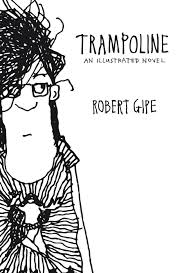Trampoline: An Illustrated Novel
- By Robert Gipe
- Ohio University Press
- 360 pp.
- Reviewed by Stephen M. Vest
- May 7, 2015
Black-and-white drawings make an impact in this poignant tale with an almost visceral sense of place.

When Robert Gipe began writing and drawing Trampoline in 2006, he decided he was going to create something different. He was a fan of graphic novels and comic books, but the thought of drawing an entire book was daunting. He enjoyed writing prose, as well, so the final product ended up being what he calls a hybrid, with more than 200 of his drawings dispersed throughout the 350-plus pages.
“I think of the process as an interview with my imagination,” said Gipe, who has been the director of the Appalachian Program at Southeast Kentucky Community and Technical College since 1997. “I just paid close attention to the voices of those around me and in my head and wrote the book in a way that I enjoyed.”
Set in the mountain coalfields of eastern Kentucky, Trampoline is the story of 15-year-old Dawn Jewell, whose father, Delbert, died in the mines, leaving behind a grieving, often drunken widow.
Dawn’s grandmother, Cora, draws her into a crusade to stop mountaintop removal — a form of strip mining — and Dawn must eventually choose between saving herself by fleeing, or the mountain by staying alongside her dysfunctional family, who “made trouble for normal people every time they came off of the ridge.” Which is why, in part, they’re no longer welcome at Kolonel Krispy, a local eatery.
As difficult as it may be to imagine angst-filled Holden Caulfield in the hardscrabble Cumberland Mountains, that is just how bestselling author Silas House (Clay’s Quilt, A Parchment of Leaves) describes Dawn’s narrative voice, mixed with True Grit’s Mattie Ross, Twain’s Huckleberry Finn, and Scout Finch from To Kill A Mockingbird.
Dawn tells us, “There was a young dude in a sleeveless T-shirt and tattoos all up his neck out stringing Christmas lights through the scraggly little sticks of trees in front of the long blue trailer next to Hubert’s. I didn’t have anyone to go Christmas shopping with me. I could have gone with one of my cousins, but such a trip would turn into a shoplifting charge or a fight in the parking lot or the endless depression of listening to my cousins talk about everybody’s problems.”
Dawn, who sports black nail polish and listens to Black Flag, is strongly independent and, like her grandmother, speaks her mind, making her an outcast in a culture steeped in contradiction and heartbreak.
“I write by ear,” said Gipe, who has also written for “Higher Ground,” a play series about life in Kentucky’s coal country. “The sound of people telling one another stories is the most precious sound in the world,” he writes in the book's foreword.
In an interview, Gipe said, “Trying to catch that sound on the page is my favorite part of writing. Most of my favorite writing — Flannery O’Connor's stories, the novels of Richard Price and Charles Portis — seems to me written by ear.”
His drawings also seem intuitive. The pen-and-ink creations, which appear throughout the text, are mildly reminiscent of James Thurber cartoons.
Jagged, dark, and honest, Trampoline is a powerful portrait of a place struggling with the economic and social forces that threaten to define it or destroy it.
Stephen M. Vest is the editor and publisher of Kentucky Monthly Magazine and the author of a fractured memoir, Unexpected Inheritance (Butler Books, 2014).

